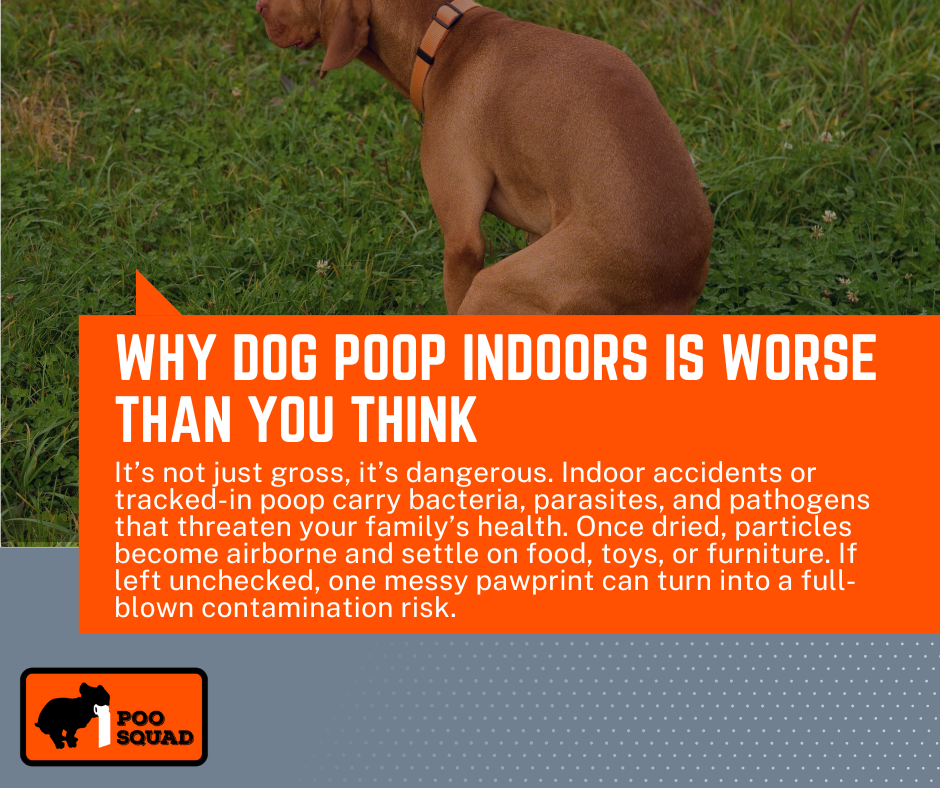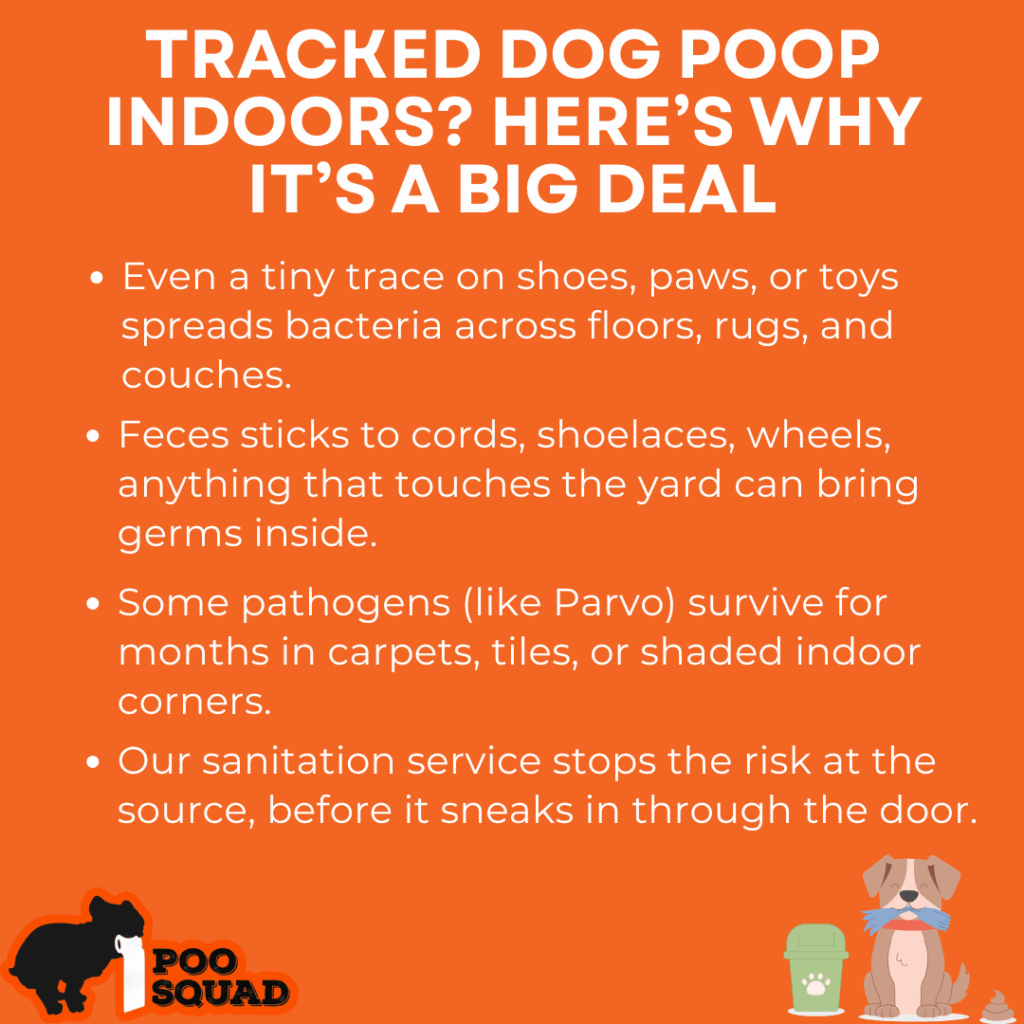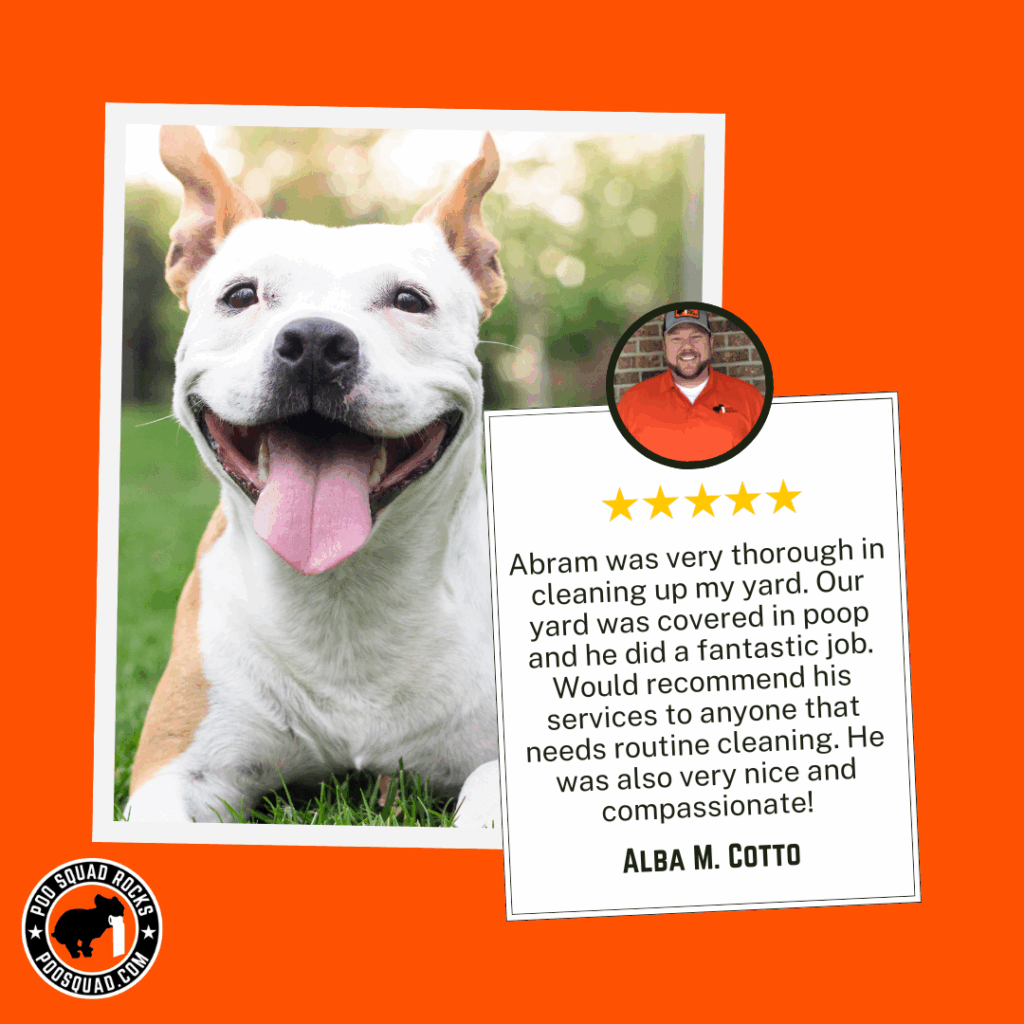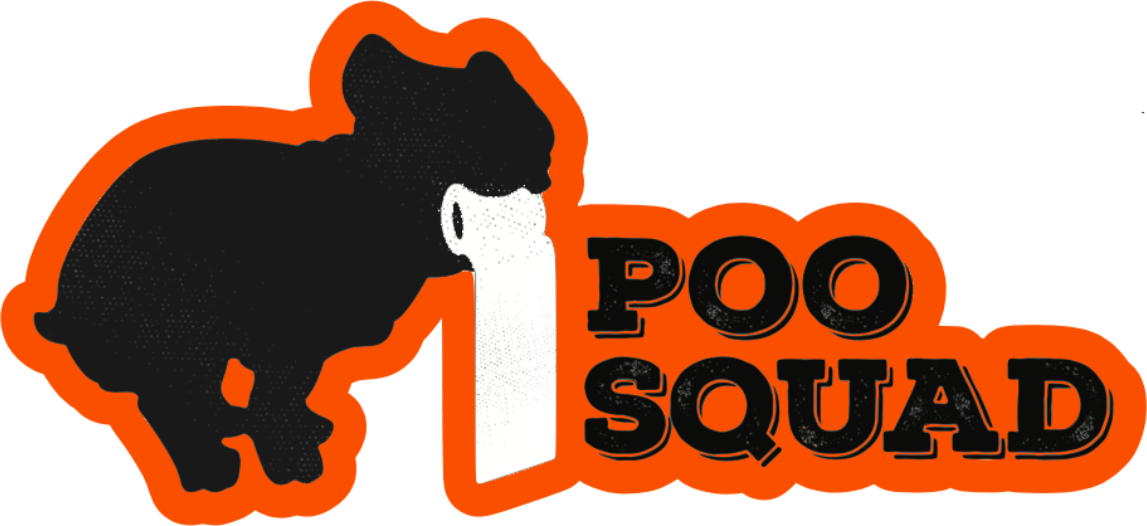Health Hazards of Dog Poop in the House | Poo Squad
Dog poop indoors poses health risks due to bacteria like E. coli and parasites such as roundworms. These pathogens can spread through air, shoes, or paws, contaminating surfaces and carpets. Quick cleanup and yard sanitation are essential to protect your family’s health.
Dog poop inside the home is not only a nuisance, it’s a legitimate health hazard. Even small amounts can introduce harmful bacteria and parasites that stick to shoes, cling to paws, and settle into carpet fibers. If you’ve ever dealt with a surprise pile in the hallway or tracked-in mess after dark, you’ve seen how fast it spreads.
One gram of dog feces can carry over 20 million bacteria. That means even an invisible trace left on a boot or toy can expose your entire home to E. coli, Giardia, or roundworms, especially dangerous for kids, seniors, or anyone with a weakened immune system.
And it’s not only about what you see. Dried particles can float through the air during vacuuming or cling to fabrics long after the smell is gone.
If your yard is not being cleaned often, or if your cleanup tools aren’t sanitized between uses, indoor contamination becomes an everyday risk. That’s why families rely on professional dog waste removal and yard sanitization: because what’s in the yard doesn’t stay there. Below, we’ll break down what’s really in dog poop, how it spreads inside, and what you can do to stop it from putting your home and health at risk.
Why Dog Poop Indoors Is More Than Gross
When dog feces ends up indoors, whether from an accident, poor yard maintenance, or tracking, it introduces serious biological hazards. It’s not simply unsanitary; it’s dangerous. Beyond the visible mess, feces contain bacteria and parasites that can affect everyone in the home, especially the most vulnerable.

It’s a Biohazard, Not Only a Bad Smell
Dog poop carries harmful organisms like E. coli, Salmonella, Campylobacter, Giardia, and roundworms. These pathogens don’t stay contained to the original spot; they spread through touch, air, and even vacuuming. Once particles dry, they can become airborne and land on furniture, food prep areas, or your toddler’s toys.
Pet waste doesn’t belong anywhere near where your family eats, plays, or sleeps. And when left on shoes, paws, or yard tools, it’s all too easy to bring those invisible risks inside.
Who’s Most at Risk?
Small children, seniors, and anyone with a weakened immune system are the most likely to experience symptoms from exposure. That includes respiratory issues, digestive upset, or even eye and organ damage if parasites like roundworms are involved. Puppies and kittens are also at high risk if they ingest or step in contaminated areas.
We’ve worked with families where repeated exposure led to chronic illness symptoms and long-term anxiety over the cleanliness of their homes. That’s one reason many of our customers sign up for recurring yard sanitization and deodorizing, it’s a peace of mind that their outdoor space is not contributing to an indoor health risk.
What Happens When You Track Dog Poop Into Your Home?
Even a small trace of dog poop on the bottom of a boot or toy can silently contaminate a home. The bacteria and parasites don’t need a big mess to spread; they only need access to your floors, rugs, or soft furniture. And that’s exactly what happens when pet waste gets tracked inside.

How Contamination Spreads
Dog feces clings to more than shoes; it gets caught in shoelaces, stroller wheels, paws, cords, and anything else that touches the yard. And if you’ve ever dealt with it firsthand, getting poop off shoes is no small feat.
The next thing you know, it’s made its way across the living room floor and into the corners of the house. We’ve seen cases where even a lawnmower cord dragged through waste outside ended up resting against a family’s garage wall indoors, transferring bacteria the whole way.
Microscopic particles become embedded in rugs and fabrics. They’re invisible to the eye, but not to your immune system. That’s why so many customers who care about keeping a clean, healthy home invest in our residential pooper scooper service, because once the waste is gone, tracking stops at the source.
How Long Can These Pathogens Live?
Parvovirus, one of the more dangerous viruses found in dog feces, can survive for months, especially in cool, shaded, or porous environments like carpet or under furniture.
Even Salmonella and Giardia can stick around for days or weeks if not properly sanitized. Traditional cleaners don’t always get the job done. Some organisms require enzyme-based or veterinary-grade disinfectants to eliminate the risk.
If I mop the tile, is that enough?
The answer depends on where the waste went and how long it sat. When in doubt, assume bacteria remain unless you’ve cleaned with the right solution and followed up with a second wipe-down. If you’ve had a serious contamination, our deodorizer and sanitization services can help ensure you’re not dealing with invisible leftovers that keep circulating inside.
What to Do if You Think Dog Poop Has Contaminated Your Home

If you think dog poop has made its way inside, on a shoe, paw, or forgotten pile behind the couch, don’t panic. But don’t take it lightly either. Acting fast, using the right tools, and knowing when to call in help make all the difference in protecting your home and health.
Step-by-Step: How to Handle Contamination the Right Way
- Isolate the area: Keep kids, pets, and guests away from the contaminated zone.
- Wear gloves and a mask: Even if the mess looks minor, protect yourself from airborne particles.
- Pick up and bag the waste: Double-bag everything, including wipes or paper towels used in cleanup.
- Use the right cleaner: Choose a pet-safe enzymatic cleaner; standard disinfectants may not kill the bacteria or parasites that matter.
- Disinfect tools and hands: Clean anything used in the process thoroughly before using it again.
- Ventilate the space: Open windows or run air purifiers to reduce airborne contaminants.
Should I mop the entire floor if poop was tracked through one room?
If there’s any uncertainty about where it went, especially in carpeted areas, it’s better to clean more than necessary rather than leave bacteria behind. And if it reached the rug, here’s how to get poop out of carpet safely. Poop spreads invisibly. One missed spot could mean days of lingering odor or worse.
When DIY is not Enough
If the poop’s been sitting unnoticed, was spread across multiple surfaces, or involved diarrhea or sickness, you may need professional support. Parasites like Giardia and roundworms can survive basic cleaning and still pose a threat.
We’ve cleaned up after situations where a homeowner thought they had it under control, until the smell lingered or their pet started getting sick. That’s why many rely on our yard sanitization and deodorizer service to stay ahead of the problem and avoid repeat exposure inside the home.
How We Help You Prevent These Risks

Our entire process is built around one thing: protecting your home, your health, and your peace of mind. Preventing poop from ever becoming an indoor hazard starts with the details most people don’t think about. But we do. Because we’ve seen what happens when those details get overlooked.
Clean Tools. Clean Shoes. Every Yard.
Every scooper on our team cleans and sanitizes their tools and footwear between yards. Every single time. This might sound like a small step, but it’s the biggest difference between safe service and cross-contamination. Bacteria, viruses, and parasites don’t need much to travel; muddy boots and unclean rakes are enough to carry them from house to house.
No Trash Can Surprises
Many services scoop the yard and toss the waste in your garbage can. We’ve seen how that story ends, flies, odors, and bacteria breeding in the same bin you wheel into your garage. We never leave dog poop behind. You’re paying to solve a problem, not shift it from your lawn to your trash can.
No One Wonders Who’s in the Yard
We show up in bright orange uniforms, drive branded trucks, and wear badges that can be verified on the spot. Your family, your kids, your neighbors, they all deserve to feel safe knowing exactly who’s walking around outside. Every tech on our team passes a background check and is trained to respect your property like it’s their own.
Optional Sanitization That Goes the Extra Mile
For families managing immunocompromised health conditions or recovering from indoor contamination, we offer yard sanitization and deodorizer treatments to eliminate lingering risks. Our products are pet-friendly, effective, and designed to neutralize bacteria at the source.
When the goal is a truly clean slate, we don’t take shortcuts.
Common Mistakes That Make Things Worse
Dog poop problems at home often start with good intentions, but a few common missteps can turn a minor mess into a full-blown health risk. Whether it’s trusting the wrong person to do the job or trying to save time with the wrong tools, here’s where homeowners get it wrong.
I Thought Dog Poop Was Fertilizer
We hear this one a lot. People think dog waste helps the lawn. But dog poop is not fertilizer; it’s packed with bacteria, ammonia, and parasites that can kill grass and contaminate soil. It’s not fertilizer, it’s a health hazard.
People who run it over with a lawnmower often don’t realize they’re spraying tiny, bacteria-loaded particles across their yard and toward their home. Bacteria can stick to your mower wheels, shoes, or even blow through open windows.
If you want a truly safe, clean yard, our sanitization services are built for exactly that: no harmful runoff, no lingering smells, and no myths about poop being good for the grass.
I’ll Use Bleach
Bleach might kill surface bacteria, but it doesn’t break down the organic waste or eliminate many of the more resilient parasites. And when used indoors, it can create harsh fumes and chemical residue that’s risky for pets and small kids.
Enzymatic cleaners, like the ones we use when clients request a deeper yard treatment, are specifically designed to target the proteins in pet waste and neutralize them at the root. It’s not about stronger chemicals, it’s about smarter ones.
Trusting the Neighborhood Kid
You know the one. Shows up late, doesn’t wear gloves, and dumps the bag in your trash or worse, your recycling bin. We’ve seen too many cases where this well-meaning shortcut ends in a sanitation nightmare. What seems like a harmless chore can go south fast when someone’s tracking poop from one yard to another, or missing piles altogether.
Preventing Future Indoor Poop Problems
Once dog poop makes it indoors, the stress and cleanup can be overwhelming. But preventing the next incident is much easier and safer when you build the right habits and systems. From routine scooping to smarter family rules, here’s how to keep your home protected long-term.
Weekly Pickup: The First Line of Defense
The less poop in the yard, the lower the chance it ends up on someone’s shoes or paws. Routine removal is the simplest, most effective way to keep bacteria and parasites from traveling inside. Many families start with weekly visits, but we also offer bi-weekly and customized schedules depending on your needs.
Our residential pooper scooper service ensures your yard stays clean, and we include photo-verified gate closures so you know your pets are safe after every visit.
Add Yard Sanitization for Extra Protection
Sometimes, pickup is not enough, especially in homes with frequent accidents, multiple dogs, or immunocompromised family members.
Adding yard sanitization and deodorizer services gives you another layer of protection by killing lingering bacteria and neutralizing odors at the source. It’s safe for pets, effective, and custom-tailored for your yard.
Teach the Household: No Shoes Inside
One of the easiest fixes: set a no-shoe policy at the door. Even if your yard is clean, one missed pile or neighbor’s pet mess can end up inside via treads or boots. We’ve seen it too often: families thinking the risk is gone, only to have a surprise incident thanks to a muddy trail or overlooked spot.
A simple shoe rack and a few conversations go a long way toward keeping your home clean and safe.
Use Our Free Pet ID Tags
Every customer can request free, customized QR-coded dog tags. If your dog gets loose and ends up far from home, anyone who finds them can scan the tag and contact you instantly. It’s a feature many don’t think about until they need it, but it speaks to the level of care we put into protecting both your pets and your peace of mind.
Your Family’s Health Is Not Worth the Risk
It doesn’t take a visible mess to create a real problem. Dog feces can quietly compromise your home’s cleanliness, your family’s health, and your peace of mind, especially when it goes unnoticed, gets tracked inside, or gets cleaned up the wrong way.
We’ve heard it all. “It was only one pile.” “We didn’t know it got inside.” “We thought bleach would do the job.” The truth? Even one overlooked accident can spread millions of bacteria and lead to respiratory issues, stomach infections, or lingering smells that no candle can fix.
You’ve got enough to handle without worrying about what’s hiding on the bottom of a boot or lurking in the carpet. Our residential poop scooping and yard sanitation services are built to take this off your plate, so your home stays safe, fresh, and ready for bare feet and dinner parties alike.
If you’re ready to make dog poop one less thing to think about, we’re ready to help.
Author: Chief Scooper
Jamie Coones is the founder of Poo Squad. He started the original location in Manhattan, KS in 2017 and has since licensed the brand to another 20 other owners with locations across the country.
